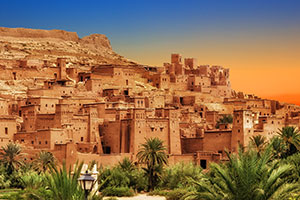Tauck
Magic of Morocco
Experience the heart of Morocco, Africa at Europe's doorstep… ancient cities, medinas, kasbahs, and souks… windswept coastline and desert treasures… on a 10-day journey through a timeless land...
Mystical, mysterious, forever fascinating Morocco... with its mix of Arabic and European cultures, unfolds its treasures on this 10-day tour that includes the great ancient cities of Rabat, Fes, Meknes, Casablanca and Marrakech... along the twisting, labyrinthine streets of medinas teeming with aromatic spice bazaars, souks, and street food vendors... down wide boulevards lined with palm trees and French colonial architecture... in stunning palaces, mosques, and gardens... in the piano bar at Rick's in Casablanca... on a camel ride... in a Berber tent under a desert sky....
Featured Destinations
Marrakech
Marrakech
Marrakech, known as the "Pearl of the South," is an oasis in southwestern Morocco at the foot of the Atlas Mountains, with rose-colored ramparts and a thousand year old palm grove. Sumptuous and exuberant, it radiates splendor and mysticism and casts a magic spell on all who visit. Marrakesh has the largest berber market (souk) in Morocco and also hosts the busiest square in Africa. Founded in 1062 as the capital of the Almoravid dynasty, it continued in the 12th century as capital of the Almohads. Marrakech remained a political, economic and cultural center for a long period. Its influence was felt throughout the western Muslim world, from North Africa to Andalusia. Marrakech also became known as a magnet for some of the greatest saints of Islam, many of whom are buried within the city. Marrakech, like Fez, is a genuinely Islamic city in both its genesis and traditions. Marrakech has impressive monuments dating from that period: the Koutoubiya Mosque, the Kasbah, the battlements, monumental doors and gardens. Other architectural jewels include the Bandia Palace, the Ben Youssef Madrasa, the Saadian Tombs and Place Jamaa El Fna, an open-air theater. The modern city was constructed in 1913 during the French occupation of the country and reflects the European influence. But the essence of the city remains the same.
|
Destination Guide
|
Fes (Fez)
Fes (Fez)
Fes (Fez) has been the capital of Morocco for more than 400 years and is home to the oldest university in the country and the leading cultural and religious center. Fes is also the home of the oldest and largest medieval city in the world, a city that has remained almost unchanged through the modern ages and still very alive. Today Fes has its own culture, pride, art and cuisine. Bustling with artisans and merchants, its captivating sounds, fragrances and colors mesmerize the visitor with a constant swirl of activity.
|
Destination Guide
|
Casablanca
Casablanca
Casablanca today boasts one of Africa's largest ports. The Place Mohammed V is the heart of the city; the main boulevards branch out from here. Casablanca is the kingdom's commercial capital; most of the cultural activities are concentrated here, from art galleries to excellent international restaurants. The Hassan II Mosque completed in 1993 is among the largest in the world, boasting the tallest minaret. Casablanca is no doubt Morocco's window on the world and is a fast-paced cosmopolitan city where trends are created and modernism parts company with traditionalism or tries to blend them. Casablanca is one of the world's most interesting and open Muslim cities. Some of the best restaurants are found along Boulevard Mohammed el Hansali and on the way to beach resorts. Casablanca's beaches and exclusive suburb are located to the east of the city along the Boulevard de la Corniche. This is a very trendy area, lined with four-star hotels, restaurants and bars.
|
Destination Guide
|
Rabat
Rabat
Rabat is the political and administrative capital of Morocco as well as the King's official residence, The Royal Palace. Across from the Royal Palace is the king's own mosque which is a wonderful example of Islamic architecture.
The city of Rabat is very clean and boasts both old Muslim quarters and beautiful remains of all periods of Moroccan history. The Oudaia Gate dates back to the Almonca Period. Its purpose is said to be ceremonial; the sight is beautiful. Another attraction, The Kasbah des Oudaia is both beautiful and peaceful. The Andalucian Gardens belong to the 20th century and boast the Museum of Moroccan Arts. Most of the houses in Rabat are painted white and have blue painted parapets.
|
Destination Guide
|
View Full Itinerary
Valid Date Ranges






